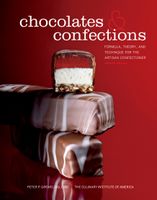Advertisement
Conching
Appears in
By Peter Greweling and Culinary Institute of America
Published 2007
Although all the ingredients in chocolate are now present, and the particles are reduced to the proper dimensions, the product still bears little resemblance to the chocolate that confectioners work with every day. It is a thick, crumbly paste that does not flow. Also, although it has a chocolate aroma, it still contains the volatile acids that were present in the fermented beans and therefore has a pronounced sour aroma. During conching, a process accomplished by long-term exposure to heat, oxygen, and agitation, the volatile acids and most of the remaining traces of water are evaporated, and the viscosity of the chocolate is improved. Dark chocolate is usually conched at approximately 70°C/158°F, for a period ranging from 3 to 96 hours. Removing the traces of water in the chocolate helps to improve the viscosity, and evaporating the lactic, acetic, and other organic acids removes the sour smell and flavor. Conching also coats all of the particles with a film of cocoa butter, allowing them to move within the system more freely, thus improving viscosity.



